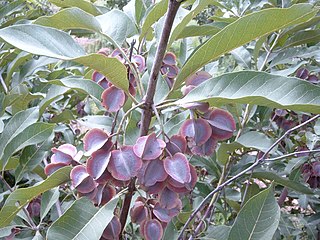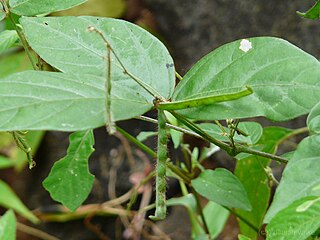
Vigna is a genus of plants in the legume family, Fabaceae, with a pantropical distribution. It includes some well-known cultivated species, including many types of beans. Some are former members of the genus Phaseolus. According to Hortus Third, Vigna differs from Phaseolus in biochemistry and pollen structure, and in details of the style and stipules.

Brachystegia is a genus of tree of the subfamily Detarioideae that is native to tropical Africa.

Combretum, the bushwillows or combretums, make up the type genus of the family Combretaceae. The genus comprises about 272 species of trees and shrubs, most of which are native to tropical and southern Africa, about 5 to Madagascar, but there are others that are native to tropical Asia, New Guinea and the Bismarck Archipelago, Australia, and tropical America. Though somewhat reminiscent of willows (Salix) in their habitus, they are not particularly close relatives of these.

Sesbania is a genus of flowering plants in the pea family, Fabaceae, and the only genus found in tribe Sesbanieae. Riverhemp is a common name for plants in this genus. Notable species include the rattlebox, spiny sesbania, and Sesbania sesban, which is used in cooking. Plants of this genus, some of which are aquatic, can be used in alley cropping to increase the soil's nitrogen content. The species of rhizobia responsible for nitrogen fixation in Sesbania rostrata is Azorhizobium caulinodans.

Anthonotha is a genus within the subfamily Detarioideae of the plant family Fabaceae.

Cryptosepalum is a genus of flowering plants in the family Fabaceae. There are 12 species, mostly trees. They are native to sub-Saharan Africa, ranging from Guinea to Tanzania, Mozambique, and Angola.

Dialium is a genus of flowering plants in the family Fabaceae, subfamily Dialioideae. Velvet tamarind is a common name for several species. The genus includes 37 species which range from the tropical Americas to sub-Saharan Africa, Madagascar, India, Indochina, and western Malesia.
Englerodendron is a small genus of legumes belonging to the family Fabaceae, that are native to tropical Africa.

Gaertnera is a genus of flowering plants in the family Rubiaceae. There are at least 85 species distributed across the Old World tropics from Africa to Asia.
Keetia is a genus of flowering plants in the family Rubiaceae. It consists of climbers or scrambling shrubs, rarely small trees.

Platysepalum is a genus of flowering plants in the family Fabaceae. It includes 13 species of small trees, shrubs, or lianas native to tropical Africa, from Senegal to Tanzania and south to Angola and Mozambique. Most species are native to the Guineo-Congolian forests of west and west-central Africa, and one is native to the tropical Zanzibar-Inhambane coastal forests of Africa's eastern coast. Habitats include tropical rain forest and seasonally-dry lowland forests, often in disturbed areas. It belongs to subfamily Faboideae.

Teramnus is a genus of flowering plants in the legume family, Fabaceae. It includes eight species of climbing herbs and subshrubs native to the tropics of the Americas, sub-Saharan Africa, the Arabian Peninsula, the Indian Subcontinent, Indochina, Hainan, Taiwan, and New Guinea. Typical habitats are seasonally-dry tropical bushland and thicket, grassland, wooded grassland, and forest clearings, often in open and dry rocky areas.

The tribe Millettieae is one of the subdivisions of the plant family Fabaceae.

Philenoptera is a genus of flowering plants in the legume family, Fabaceae. It includes 11 species of trees, shrubs, and more rarely lianas native to sub-Saharan Africa. Typical habitats include seasonally-dry tropical forest, woodland, wooded grassland, and bushland. Four species are native to the Zambezian region, 3 species to the Sudanian region, 2 species to the Zanzibar-Inhambane and Tongaland-Pondoland regions, 1 species to the Somali-Masai region, 1 species to the Guineo-Congolian region, and 1 to Madagascar.

Dichapetalum is a genus in the plant family Dichapetalaceae. The plants are tropical lianas native mainly to tropical regions of Africa, Asia, Malesia, the West Indies, Australia and Latin America. Some species are known to be poisonous due to the presence of toxic fluorinated compounds such as fluorocarboxylic acid and dichapetalins, a unique class of cytotoxic compounds that are only found within this genus.













